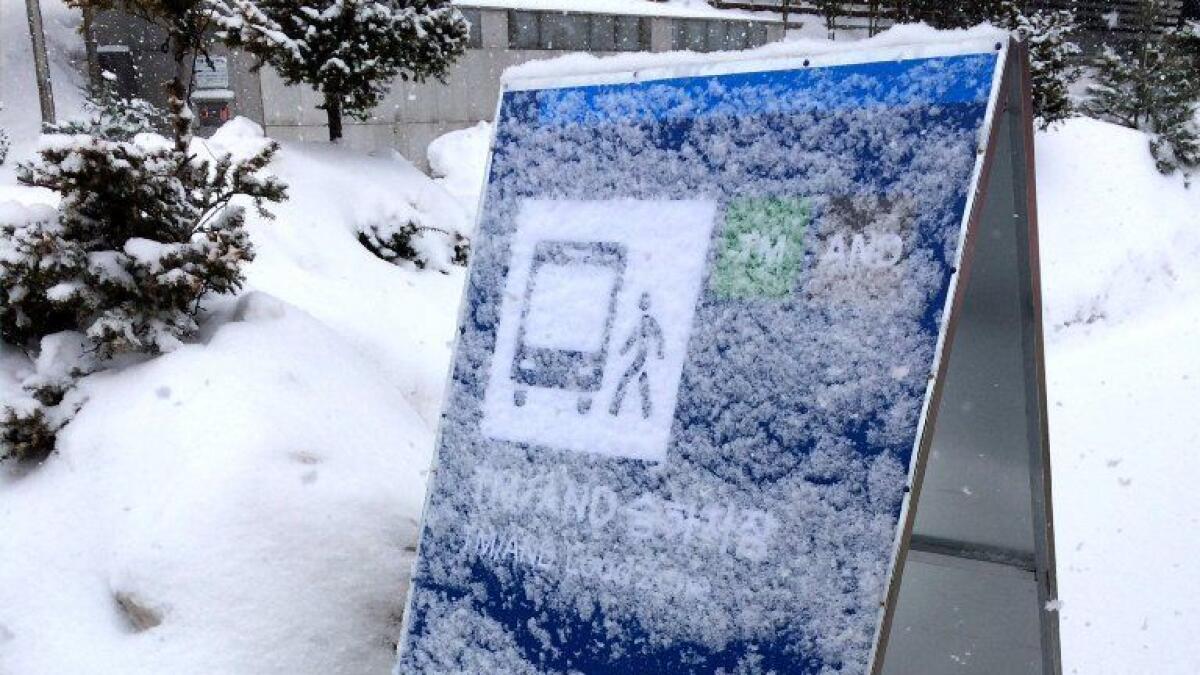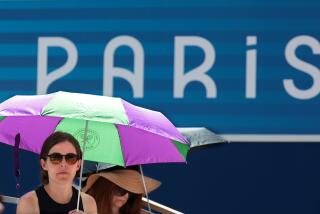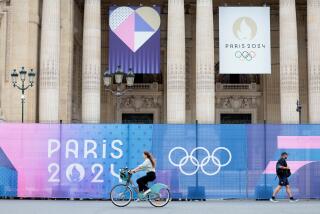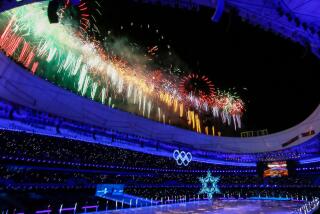Athletes and fans will have to adjust to unusually cold Olympic Games

- Share via
Reporting from Pyeongchang — The American speed team — the men and women who scream down mountainsides in the downhill and the super-giant slalom — are packing extra equipment at the 2018 Winter Olympics.
Rolls of thick tape. To put across cheeks and down noses. To ward off frostbite.
“When you’re going 70 to 80 miles an hour, that adds a lot of windchill,” veteran Ted Ligety says. “You have to tape your face.”
After nearly a decade of sunny skies and melting snow, the Winter Games have finally landed in a host city that is downright frosty.
Temperatures in Pyeongchang, South Korea, have lingered at or below freezing all week in a cold snap that has even the locals bundled up and hunched over as they scurry along streets.
The weather has forced skiers and sliders to adjust their equipment and consider different techniques. Organizers have erected wind barriers around competition sites and devised ways to keep fans warm in the stands.
With forecasts calling for a gusty 14 degrees at the opening ceremony on Friday night, everyone arriving at the outdoor Olympic Stadium will receive what amounts to a survival kit: A blanket, a beanie, a wind-breaking poncho and hand, foot and chest warmers.
American athletes will march in the traditional parade of nations wearing parkas equipped with battery-powered heating elements. Others might not be so well-fortified.
“Not only is it cold, it chills you to the bone,” said Kevin Boyer, a Canadian skeleton racer who arrived in Pyeongchang to temperatures of minus-4 degrees. “The wind is the worst.”
This isn’t like the 2010 Vancouver Games where organizers laid straw over bare spots on mountain courses and added snow trucked in from higher elevations.

Four years ago, in Sochi, the Russians stockpiled more than 700,000 cubic meters of snow under thermal blankets. At some venues, competitors found themselves slogging through sloppy conditions.
“At the last couple of Winter Olympics, it hasn’t felt much like winter,” said Manuel Osborne-Paradis, a Canadian downhiller. “You got warm clothes and you were sweating all day.”
Experts have warned that as temperatures around the globe inch higher each year, it could become increasingly difficult to find suitable locations for winter competitions.
There have been no such concerns in Pyeongchang.
Located on the eastern edge of Asia, the region features a continental climate with February temperatures averaging 22 degrees in the mountains.
“There tends to be this high-pressure system that sets up over Siberia,” said Jim Steenburgh, a professor of atmospheric sciences at the University of Utah. “So they see a lot of cold, dry winters.”
Winds sweeping down from the Manchurian Plain over the last few weeks have nipped at exposed skin and wormed inside gloves and boots. It has been something of a shock to athletes just off the World Cup circuit in Europe and North America, where the days have been kinder.
When it’s like this with wind blowing on the ice, it becomes like marble. The ice gets really, really hard and we end up skidding.
— Chris Mazdzer, an American luger
The most-recent forecast from the Korea Meteorological Administration calls for a brief warming on Saturday with a chance of snow. By Sunday, chilling winds should return.
“The temperature will be colder than the norm for a few days … due to incoming cold air from the northwest, as well as a strong windchill factor,” officials said.
The trick will be adapting to conditions.
Skiers are looking forward to fast track. As Ligety said: “We actually like that really hard, man-made surface better than having a ton of natural snow. It makes for great racing conditions.”
But plastic tends to stiffen in sub-zero temperatures, so racers might have to use heat packs to keep their boots pliable. They might also need to modify turning styles to generate momentum on a dry, chalky surface.
“It will be interesting to see how people deal with it,” American skier Wiley Maple said.
At the Phoenix Snow Park, course workers should be able to carve a clean, even halfpipe out of the icy surface, but snowboarders will need sharp edges to keep from slipping when they land their tricks.
A similar challenge faces bobsledders, lugers and skeleton racers at the Alpensia Sliding Centre.
“When it’s like this with wind blowing on the ice, it becomes like marble,” said Chris Mazdzer, an American luger. “The ice gets really, really hard and we end up skidding.”
But technical adjustments go only so far.
Wind can raise havoc at the ski jumping center where organizers have erected those screens in hopes of shielding the venue. Biathletes will have to make do as they exit the cross-country course to fire at targets.
“Trying to shoot precision rifle marksmanship when you can’t feel your hands is fairly challenging,” said Lowell Bailey of the U.S. team.
Not everyone is fretting about the weather. Finnish ski jumper Janne Ahonen said, “It is cold and windy here, but it’s also cold in Finland in the wintertime and it’s not a big problem for us.”
With fans undoubtedly wearing gloves to the opening ceremony — which pretty much rules out clapping — organizers have added a small drum to their kit so the crowd can make some noise.
As competition begins in earnest over the weekend, technicians will pore over equipment and coaches will review strategy with their athletes.
“It’s the coldest Olympics I’ve been at so far,” said Ligety, now competing in his fourth Games. “We’ll have to figure some stuff out.”
And maybe they’ll need some extra tape.
Follow @LAtimesWharton on Twitter
More to Read
Go beyond the scoreboard
Get the latest on L.A.'s teams in the daily Sports Report newsletter.
You may occasionally receive promotional content from the Los Angeles Times.







